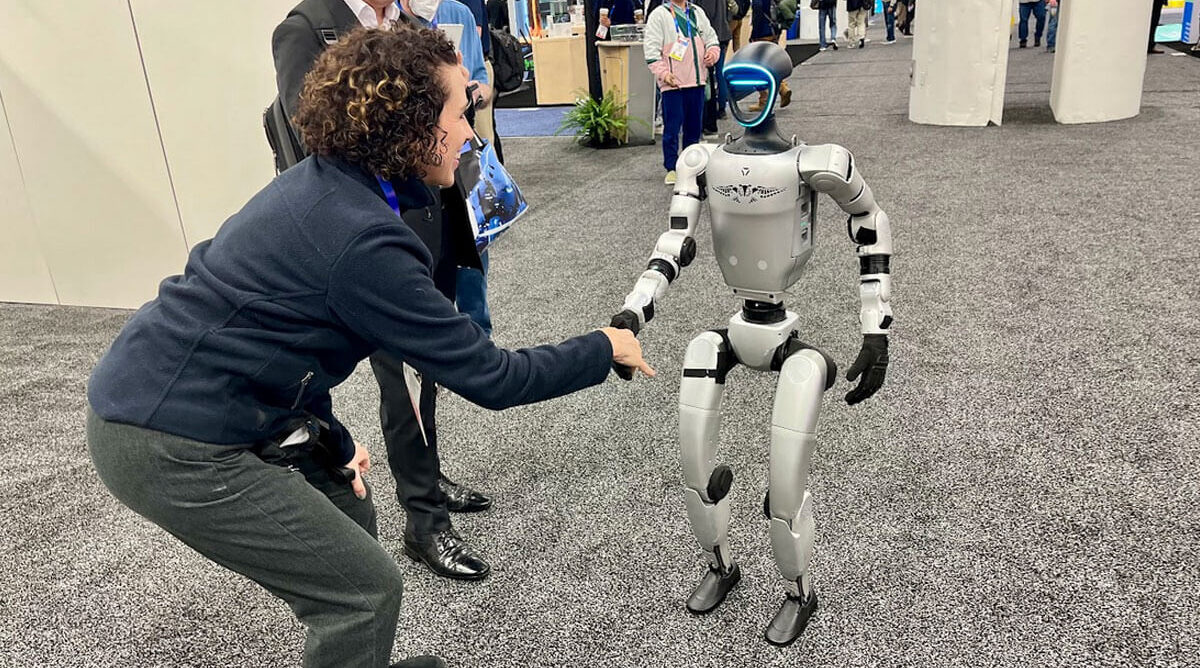The Consumer Electronics Show (CES) 2025 has once again proven to be a hotbed of innovation. Even with over 4500+ global tech industry exhibitors, it wasn’t hard to find the robots – because they were everywhere! Of course, there were various robot dogs marching around the floor. But much more than that, though, we found several cool humanoid and practical bots from companies all who seek to make the world a better place. Here’s a brief introduction to a few of them, so you can dive deeper on your own, if you want to!
Old World Labs’ (OWLs) AI-Integrated Humanoids
Old World Labs (OWL) stole the spotlight with its 4-foot tall humanoid robot. This small but mighty machine showcased unprecedented dexterity and abilities, fluid movements and natural interactions.
At the heart of OWL’s humanoid revolution lies their Replicants system, a first-of-its-kind platform that the company unveiled at CES. It enables self-replicating humanoid robots equipped with sophisticated AI agents. These latest advancements enable AI agents to seamlessly inhabit and operate humanoid robots that can execute complex tasks autonomously. It grants them the ability to reason, interact,and adapt to 3D environments.

This AI not only powers the robots’ decision-making processes but also enables them to learn and adapt in real-time. This breakthrough effectively bridges the gap between physical robotics and immersive digital experiences. The AI’s ability to process vast amounts of data and make split-second decisions has implications beyond the realm of robotics to industries such healthcare, disaster relief operations, manufacturing and space exploration.
At the OWL booth, it was clear that the future of human-robot interaction has arrived. And it’s more incredible than we ever imagined.
IntBot’s Interactive “Nylo” Bot Powered by NVIDIA Cosmos
California-based IntBot unveiled its latest creation, Nylo, a humanoid robot that leverages NVIDIA’s Cosmos platform (which has an open license and is available on GitHub) with an aim to revolutionize the service industry.
With a unique blend of functionality and personality, Nylo presents with a snarky and interactive persona to make human-robot interactions more engaging and natural. The company aims not just to create a robot but rather to craft an experience that seamlessly integrates humanoid robots into everyday life.
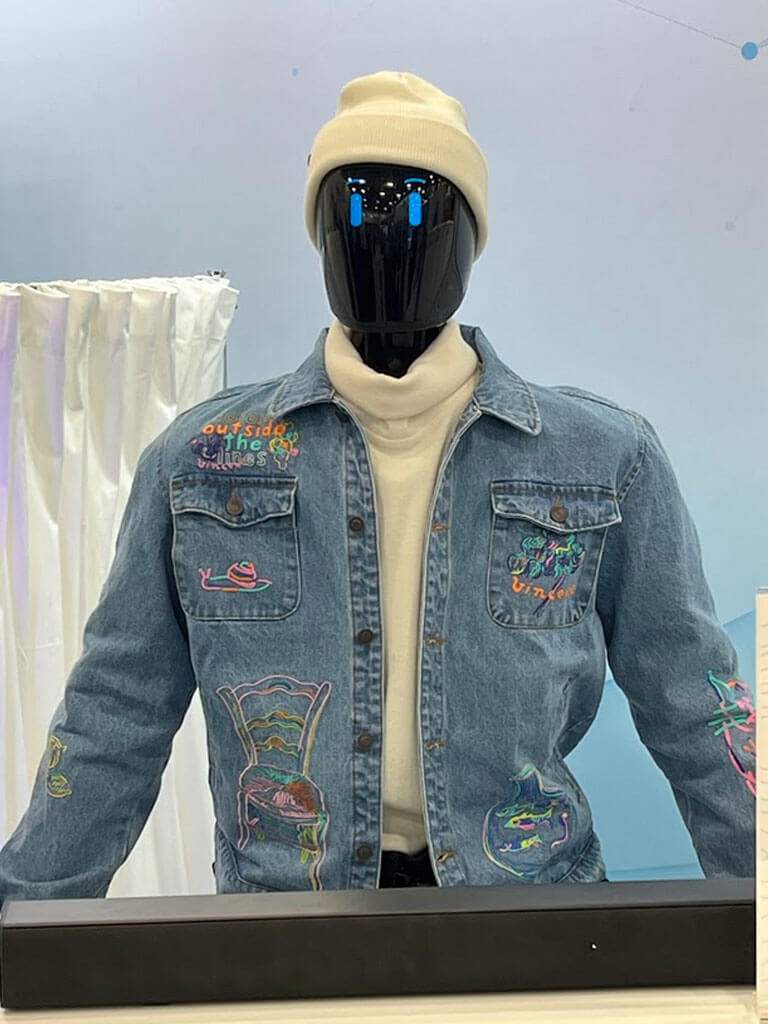
The partnership with NVIDIA has been crucial in achieving this vision. IntBot’s collaboration with NVIDIA for synthetic motion generation and advanced AI training has enhanced Nylo’s physical AI capabilities for more fluid movements and advanced decision-making processes. The robot’s advanced AI allows it to adapt to various service industry environments, from restaurants to hotels. Nylo can perform tasks such as taking orders, delivering items, and even engaging in light conversation with customers.
As the robotics industry continues to evolve, IntBot’s Nylo represents a significant step forward in creating humanoid robots that can truly enhance and transform the service sector. With its advanced AI capabilities and engaging personality, Nylo is poised to redefine human-robot interactions in the years to come.
Pollen Robotics’ Bio-Inspired “Reachy 2” Dev Bot
France-based Pollen Robotics revealed the first open-source humanoid robot specifically designed for the development of embodied AI and real-world applications. In other words, it’s a state-of-the-art humanoid Dev Bot.
Reachy 2 features a design that closely mimics human proportions and movements. The robot’s arms boast 7 degrees of freedom (DOFs) which allows for remarkably human-like gestures and interactions. It also has incredible strength and dexterity, with the ability to lift objects weighing up to 3 kg (or 6.6 lbs.).
Reachy 2 can do all of these things because it boasts a powerful CPU-driven system optimized for machine learning. This robust computational foundation enables seamless integration with modern AI frameworks to open up new possibilities for adaptive behaviors including advanced problem-solving and the ability to learn and adapt to new tasks in real-time.
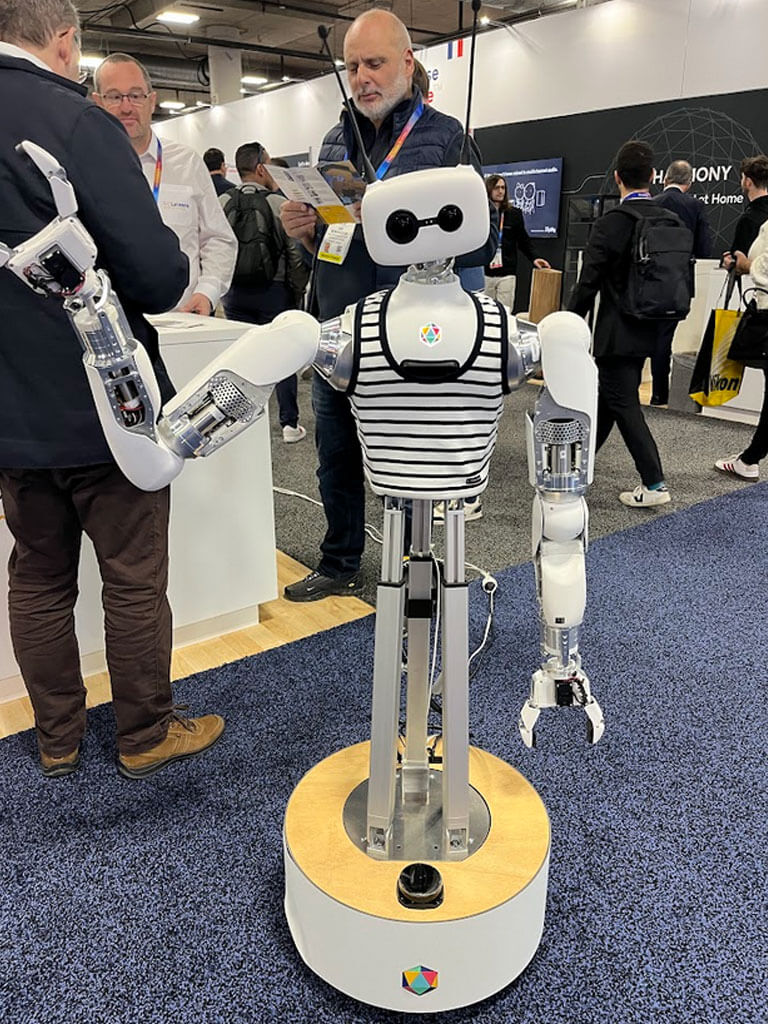
One of the most exciting aspects of Reachy 2 is its integration with virtual reality (VR) technology. Donning a VR headset, one can control Reachy 2’s arms, hands and head in real-time. This immersive experience allows users to see through the robot’s cameras to provide a unique perspective on human-robot interaction.
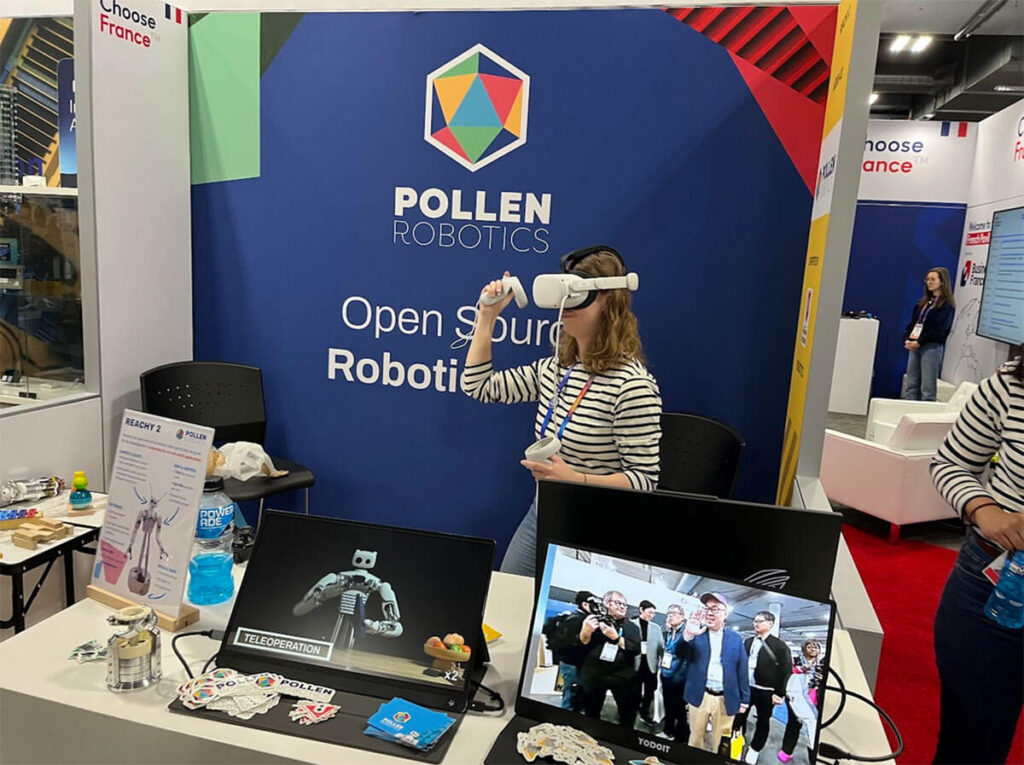
Pollen Robotics has taken Reachy 2 to the next level by introducing a mobile base option. This addition significantly expands the robot’s capabilities by allowing it to navigate complex environments with ease. The mobile base features three omniwheels, various sensors and a LiDAR system, all of which make it ideal for a wide range of applications.
With its human-like design, VR integration, mobility options and AI capabilities, make Reachy 2 a stand-out robot…even in a big crowd.
Jizai’s Customizable General-Purpose AI Robot “Mi-Mo”
美雲- Mimo is a Japanese name that 美 means “beauty, beautiful, pretty” – and Jizai Inc.’s little “Mi-Mo” robot (which looks a lot like the Pixar light by the way) fulfills its namesake in several respects.
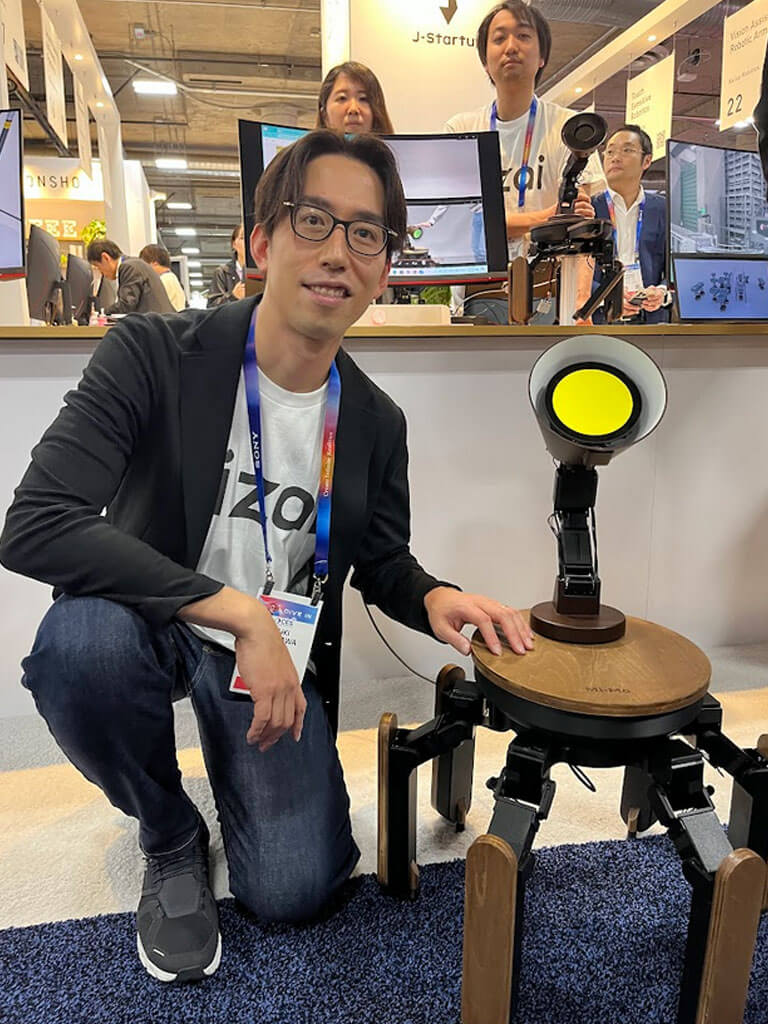
Jizai, a Japanese innovator in generative AI and robotics, showcased Mi-Mo – another dev kit – as a leap forward in robotics. It combines visual, audio and movement capabilities powered by multiple AI models. This integration allows Mi-Mo to think and act autonomously and dynamically respond to its environment.
What sets Mi-Mo apart is its unprecedented level of customization. Users can modify and add to Mi-Mo’s AI models, effectively allowing the robot to grow smarter over time. This community-driven approach to AI development promises to create a diverse ecosystem of applications and capabilities.
Yuki Ishikawa, CEO of Jizai, envisions Mi-Mo as a solution to pressing societal challenges, particularly in aging populations with declining workforces. By developing hardware that can be controlled through multimodal AI, Jizai aims to bring general-purpose AI robots into everyday life.
At CES, Jizai opened its waitlist for the “Mi-Mo Developer Kit” to allow early adopters – in particular AI model developers, robot developers, and research institutions – to be at the forefront of Mi-Mo’s development.
OpenDroids’ “R2D3” Personal Assistant Robot
California-based OpenDroids made some waves with its advanced dual-arm lifting platform designed for tasks like food service, housekeeping, and beyond – the R2D3 (think: “Rosie”).
Combining cutting-edge AI with versatile hardware, this intelligent machine continuously learns and adapts, becoming more efficient with each task it performs. Its modular design features interchangeable components and advanced sensors, to allow for a wide range of applications across various industries. Using sophisticated sensor-based obstacle avoidance to ensure smooth operation, the R2D3 can easily navigate in complex environments. Notably, the robot’s open-source nature encourages user customization and modification to foster a collaborative ecosystem.
Standing at an optimal height for human interaction, the R2D3 boasts an array of capabilities that cater to both domestic and professional needs. In the home setting, R2D3 can fetch drinks and snacks, operate appliances like coffee makers and cook pancakes.
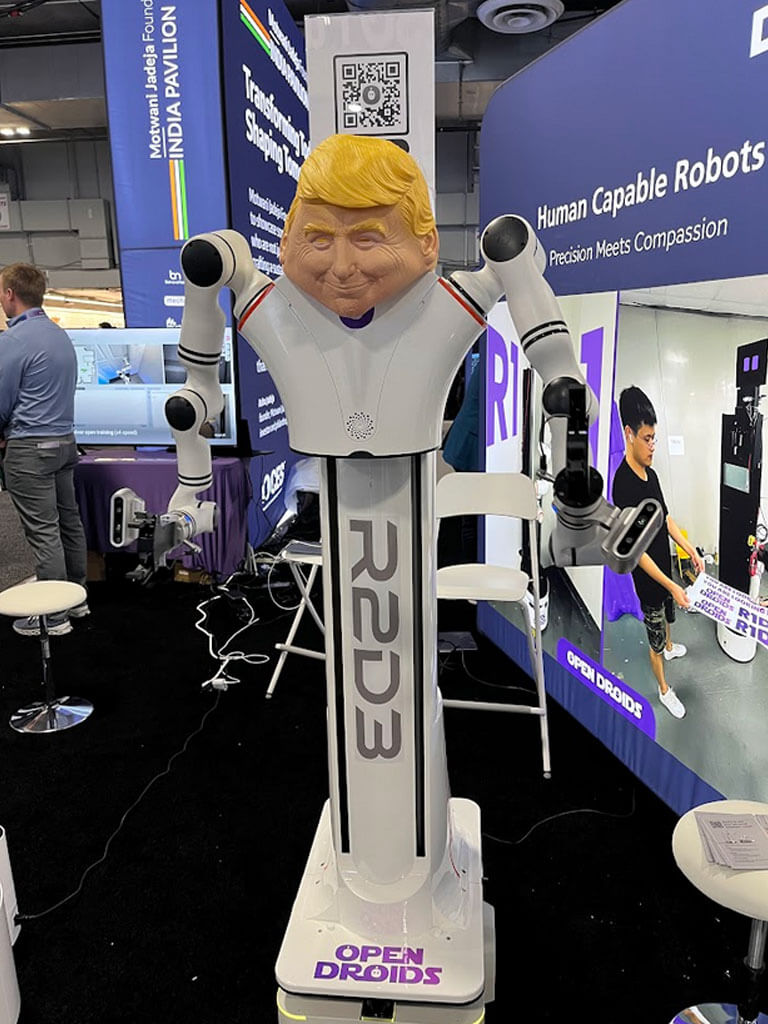
For businesses, R2D3 can perform inspections, deliver items to staff or customers and generally streamline office logistics. Its capacity to operate machines opens up new possibilities for automation across various industries.
Folks, the Jetsons have truly arrived (think “Rosie” the maid).
Enchanted Tools’ “Mirokai” Social Robot
France-based Enchanted Tools, a pioneer in social robotics, turned heads and sparked conversations around its Mirokai, an embodied AI social robot. Born on November 29, 2021, this charming robot hails from the fictional Planet Nimira, adding a touch of whimsy to its backstory.
Standing at 4 feet tall with its spherical base and the advanced tech behind it, Mirokai boasts smooth, omnidirectional movement, navigation in complex spaces and collision avoidance. While Mirokai impresses with its technical specifications—including a maximum speed of 1.8 mph and a weight of 67 lbs—it’s the robot’s ethical framework that truly sets it apart. Enchanted Tools has prioritized ethical compliance so the bot can act as a companion in sensitive environments, with a particular focus on healthcare.
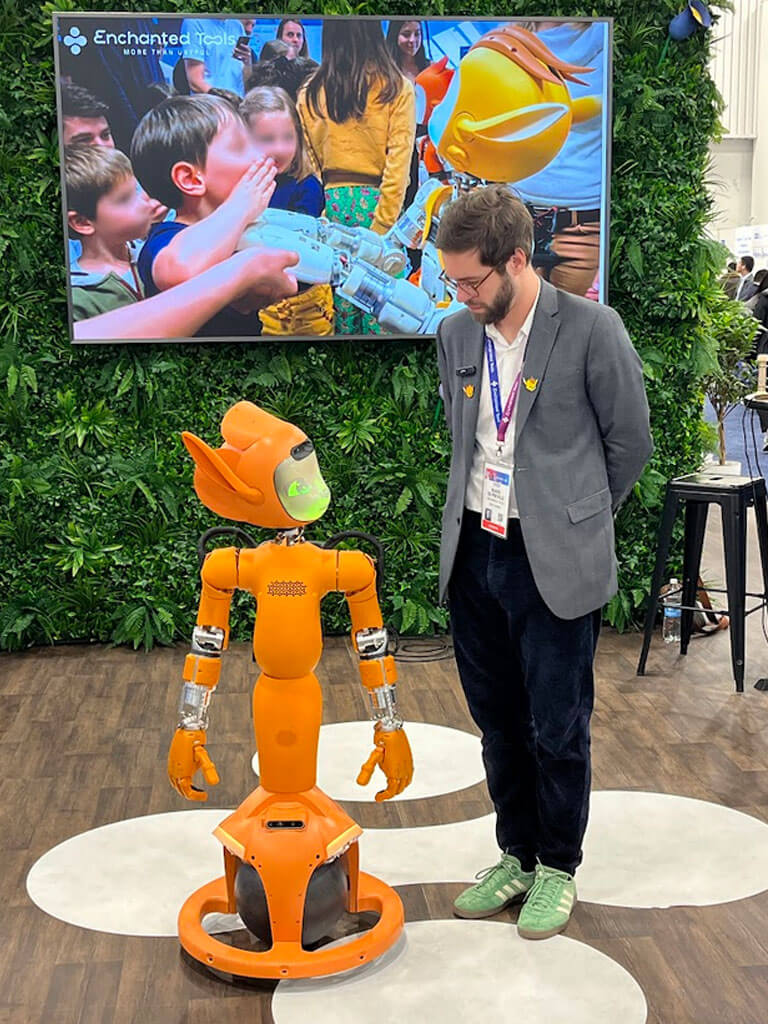
The robot’s AI-driven personality fosters a sense of connection that is particularly valuable in healthcare settings where empathy and understanding are crucial. In healthcare the robot’s capabilities extend to:
- Assisting with patient care, including monitoring procedures and hospital stays
- Efficiently handling repetitive tasks to alleviate staff workload
- Collaborating with medical professionals to enhance patient experience
Mirokai and all the other robots at CES stand as a testament to the rapid advancements in robotics. This year, CES gave us a glimpse into the future of technology with real-world present-day robotic solutions poised to enhance human capabilities across various sectors.

